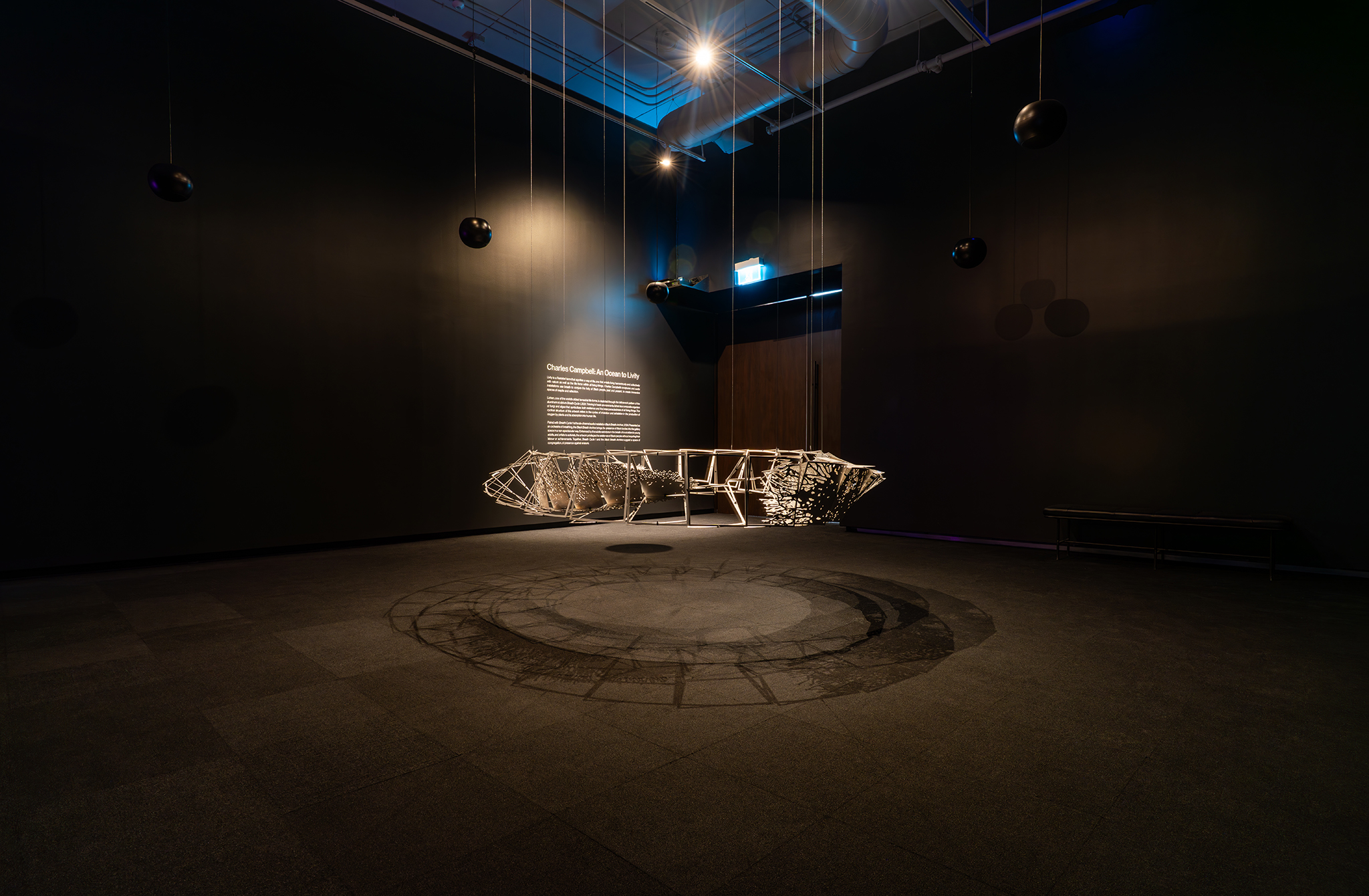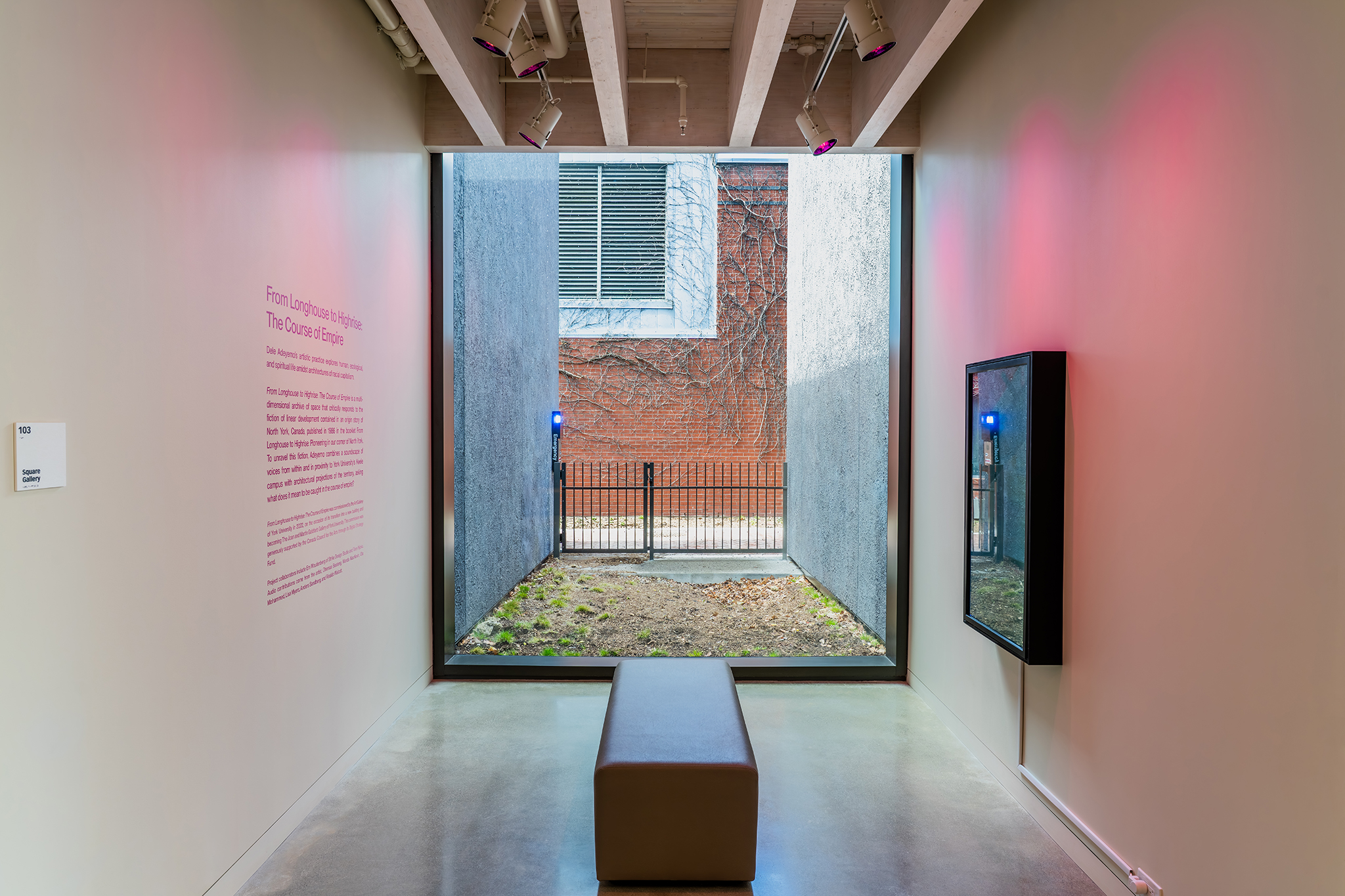York’s New Gallery Takes Shape
by Eric Mutrie
photography by Kyle Finbow
Art lovers might detect a hint of cubism in the architecture of York University’s new Keele Campus gallery. Officially, Hariri Pontarini Architects, the Toronto firm behind the project, points to another source of inspiration. “Imagine a butterfly with its wings extending from a central core,” says founding partner Siamak Hariri. But rather than the curved structure that might suggest, the design is instead a combination of hard-edged geometric shapes. In other words, it’s an abstract, cubist butterfly – or at least, it would look like one from above. And after two years of construction, it has finally emerged from its chrysalis.
The 1,115-square-metre Joan and Martin Goldfarb Gallery opened this past fall with art spread across three main exhibition spaces – the Rectangle, Square and Triangle galleries, all with six-metre-high ceilings – that each radiate from a long lobby block. A fourth room, a glassy box dubbed the Pavilion that hosts talks and performances, sits in the final corner. “People can be led by their curiosity on their own routes, drawn by glimpses of installations they catch from the lobby,” Hariri says.
This summer, ethereal video animations of a wooden boat by Tuan Andrew Nguyen fill one area, while multi-layered landscape paintings by Andrea Carlson hang in another. This latest season of exhibitions runs through Aug. 3.


Standing in Harry Arthurs Common outside, the Goldfarb Gallery is easy to spot, thanks to its Algonquin limestone facade – a kind of canvas unto itself. “This particular cut of stone was once considered leftover – the rough edge of quarried rock – and has been likened to crust,” Hariri says. “I found its textures appealing.” Sloped toward the front entrance, the building’s long stone wall draws passersby inwards, while also giving the Triangle Gallery its distinctive shape. Apart from a few floor-to-ceiling windows, the rest of the exterior is covered in a dark, textured stucco that has its own rugged character.
People can be led by their curiosity on their own routes, drawn by glimpses of installations they catch from the lobby
Previously, this site was home to an east-west colonnade structure, as well as a fenced-in stormwater garden and a north-south footpath that offered a shortcut across campus. To maintain that connection, the walkway remains in place, now joined by fresh landscaping. “The design encourages students to pass through the building as they move about campus,” Hariri says. Sure enough, visitors to the Goldfarb Gallery have their pick of three different points of arrival: the front door, a secondary south entrance and a ramp that connects to the building next door.
That adjoining facility, the Accolade East Building, was actually the former home of York’s art gallery, previously known as the AGYU. As part of the institution’s expansion (funded by a $6-million donation from the Goldfarbs), this earlier space was converted into a storage vault for the University’s permanent collection, which includes works by artists Helen Frankenthaler, Norval Morrisseau and Frank Stella – all gifts from the Goldfarbs. Art from this permanent collection now rotates through view as part of a “Visible Vault” display.


Hariri Pontarini Architects, which won the commission for the project through a design competition, is well-known for its cultural work – the studio is also designing the Royal Ontario Museum’s next big transformation. (Its portfolio includes another York project, too: the nearby Schulich School of Business.) Goldfarb Gallery director Jenifer Papararo praises the firm’s vision. “The biggest surprise was the Triangle Gallery,” she says. “None of us have worked in a shape like that before – we generally get white cubes – but once you’re in there, it feels bigger than it is and it gives a great sightline across campus.”
The new building’s impact is being felt beyond York, too.
“AGYU has held an important place in the ecology of contemporary art spaces in Toronto and Canada. Historically, the gallery has always punched above its weight by having an international program that resonated locally,” says Adelina Vlas (MA ’02), who is now the head of curatorial affairs at Toronto’s Power Plant Contemporary Art Gallery. “With its new name and unique architecture, the Goldfarb Gallery will soon become a recognizable space and a highly coveted venue for artists to show.”
With its new name and unique architecture, the Goldfarb Gallery will soon become a recognizable space and a highly coveted venue for artists to show
At a time when the city is losing cultural venues – more than 40 have closed since 2019 – the new space is also providing a welcome home base for Jane Street Speaks, an arts organization from the surrounding Jane and Finch neighbourhood that uses the Goldfarb’s Pavilion to host showcases of emerging rappers, singers and spoken word poets.
“The space is lovely,” says founder Nathan Baya. “I’m happy to see that community members who don’t typically benefit from new, aesthetically pleasing spaces are able to have this partnership that allows us to connect here.”
Hariri, for his part, is excited to see the role that the gallery will come to play – both on campus and in the city at large. “The way that it announces itself to York Boulevard and the Common, it will not be difficult to find your way there,” he says. “It’s meant to be a place for inspiration and reflection.” ■